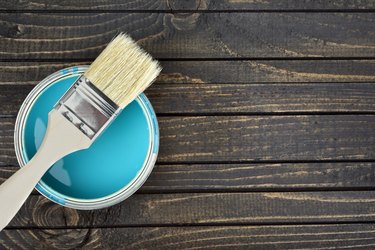Interior household caulking relies on painter's caulk, a siliconized acrylic latex caulking compound that is perfect for indoor projects. Its ability to cure to a paintable surface in an hour makes it convenient for filling small gaps and holes during painting preparations. It is also one of the most affordable caulking compounds at a cost that is less than half of some specialty and premium caulking. While versatile, it is not suitable for all applications, and choosing the right caulk is an essential element to successful application.

Video of the Day
Technical Talk
Painter's caulk should be applied at temperatures 40 degrees Fahrenheit and rising and must be kept from freezing until fully cured. It has a working time of five minutes before skinning and will cure to a paint-able surface in 60 minutes under normal conditions. Cartridges should be used within 24 hours of opening to provide best results. For clean up, soap and water is recommended before curing, after curing scraping is typically necessary to remove caulking.
Video of the Day
When to Use Painter's Caulk
Painter's caulk is appropriate for interior and exterior surfaces. It is primarily used to seal dry joints where minimal moisture will be present. It can be used to provide a weather tight seal around doors and windows and to seal joints in woodwork. It also works well for sealing joints between two different building materials, such as brick and wood. Gaps up to 1/4-inch can be filled with painter's caulk alone; wider gaps require backer rod or other filler and may require multiple coats.
When Not to Use Painter's Caulk
It is not recommended for use on joints that are submerged or frequently damp. Acrylic- and latex-based caulks are recommended for indoor projects, since exposure to water or the elements can cause the caulk to weather and become brittle over time. Silicone-based caulk is made for outdoor projects, and is made to secure sinks and showers. It acts as a moisture repellant. Pick silicone caulk for any project that is exposed to water or damp for long periods of time.
Horizontal joints above and below doors typically require an initial bead of silicone to insure they are watertight before applying a top coat of painter's caulk to prime for paint. Joints that are subject to movement and vibration should not be sealed with painter's caulk. Un-backed gaps wider than ¼-inch or those that join more than two surfaces are not recommended to be filled with painter's caulk.
How to Apply Painter's Caulk
A heavy duty caulking gun provides best results. Only open the tube as wide as the smallest bead you need to start. Fill small gaps first. The tube can then be opened wider for larger gaps. Apply the caulking in a steady, even bead. A dampened finger works well for smoothing beads into a smooth, concave line. When using to fill nail holes, apply a small amount to the hole with the tip of a finger. Wipe any excess immediately with a damp rag or paper towel. Solvents, such as mineral spirits and acetone can also be used for clean up.
Tips and Tricks
Cut your nozzle tips at an angle for easier application. Always keep a cup of clear water handy for shaping and smoothing and when working on large gaps, allow the first coat to skin over before applying a second coat to make the caulk easy to work. Slide a nail into the tip of your gun to seal the caulk if you need to set it aside for more than five minutes to prevent skinning.